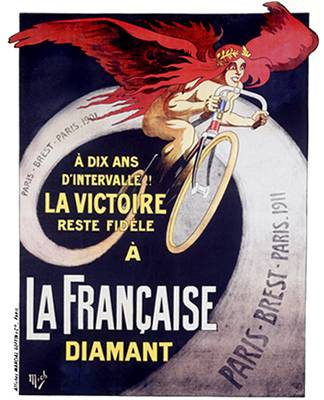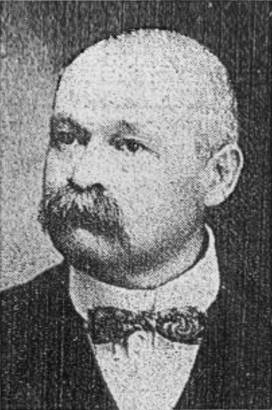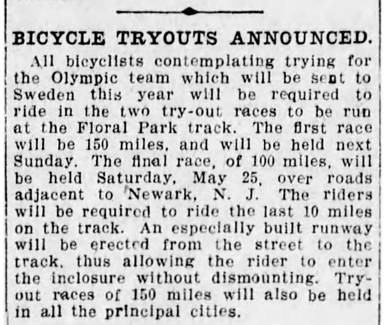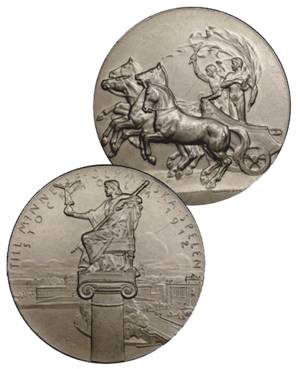
On a Sunday morning in May, 1912, onlookers cheered as a local cyclist sped through Hicksville. Jerome "Pete" Steinert was midway through the first of three long laps, competing in a race which would not end for seven more hours. Although the finish line was at Floral Park, Steinert was on his way to Stockholm.
Hicksville's Steinerts
Pete was the seventh of nine children. He was born to Agnes and Joseph Steinert in Hicksville late in 1883, not long after the Steinert family moved east from the Bronx. In those years, the family lived north of the central part of Hicksville village, on "the Jericho Road" (now North Broadway). Both his father and his grandfather, Herman Steinert, were lawyers. As late as 1890, Joseph Steinert was listed in the New York City Directory as a resident of Hicksville, but one who still shared law offices in the City with his brothers Henry and Max.
|
Known throughout the town as Judge Steinert, even after he retired from the bench, Joseph Steinert was an educated and capable man. He gained prominence, both in the day-to-day life of his community, and in county politics. Over the course of his lifetime, he was elected or appointed to a number of public offices, including:
from a photograph in the Hicksville Archives at the Hicksville Public Library |
|
Two Clarifications

These illustrations, respectively from the 1910 U.S. Census and a 1912 newspaper article, are part of the evidence which demonstrates that Joseph was Jerome's father. They are included here because some published material, written before these resources became more easily available, indicates that Judge Steinert was Pete's uncle. Presumably, the only resources available to its authors were oral histories and personal journals, which sometimes can be imperfect.
Another point to clarify is that, as implied by the above list of offices held by Judge Steinert, Hicksville once was part of Queens County. County was not carved out of Queens until 1899.
Early Racing Career
It is not clear when Pete Steinert first entered an organized cycling race. The earliest report of formal competition which I have found refers to an event held on May 30th, 1901, when he was 17 years old. He probably already had racing experience, for on that day he was victorious in two races, one of them ten miles long. As time went by, Pete showed confidence in his riding, competing on tracks, in road races, in hill climbs - and even in something described as a "Liverpool Steeplechase." Although Long Island offered opportunities in many places (e.g., Glen Cove, Valley Stream, Ronkonkoma, Manhasset, and Brooklyn), he was not content to remain a local success.
|
He also raced at the velodromes of northern New Jersey, which regularly attracted the fastest cyclists in the Eastern United States. By 1909, he was ready for the U.S. National Championships (held that year at the Vailsburg, NJ track, shown here). He finished first in his qualifying heats for the one mile event, and solidified his place in the sport by placing third in the final. |
|
Any joy was short-lived, however. A month later, Steinert was on the same track for a regional championship. During one race, he was riding part-way up the banked track, following close behind Clarence Carmen, the national champion. Suddenly, Carmen tried to dart to the inside, between two cyclists. He struck one of their wheels and went down. Pete could not help but crash over him; both men were seriously injured. One of Steinert's collarbones was broken into three pieces. It was time to convalesce.
Not Today's Bicycles
Early bicycles had been too primitive to race. The wooden bone shakers of the 1840s were slow and awkward, even tortuous to ride. By the 1870s, things had evolved; there were new bicycle frames made of metal tubing, wheels with tensioned wire instead of wooden spokes, and solid rubber tires. When these things came together, people realized that they had bicycles which they could race, and they did.
Like early airplanes, these bicycles were not sleek or lean. Indeed, they looked a bit ridiculous. In England, they were called penny farthings (i.e., a small coin next to a very large coin); in other countries, they were known as ordinaries. The nattily-attired young Californians below are not racing their machines; this must have been a pleasure ride. You can see how relaxed and carefree they are.
https://commons.wikimedia.org/wiki/File:Pennyfarthing-1886.jpg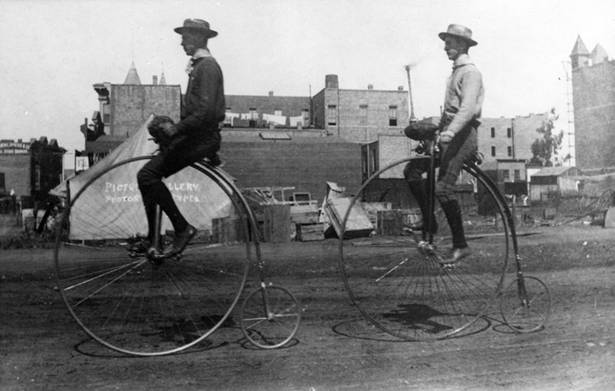
Why were the front wheels so big? There were no gears; the rider pedaled a crank that was part of the front axle. For the ordinary to go faster than a child's tricycle, the front wheel had to be larger. To win races, it had to be MUCH larger, with a diameter of 60" or more. Ordinaries were fast (for their time) and they were dangerous. A fall, or even just climbing off, was risky. Moreover, there were no brakes. As with the bicycles used for modern sprints, to slow his machine, a cyclist resisted the turning of the pedals with his feet and leg muscles - something which was practically impossible when his legs were so fully extended as those in the picture above. To stop quickly, an accomplished "wheelman" leaned forward to grab the front tire and stop its rotation. In such a stop, he risked being catapulted over the ordinary's front wheel, and on the way forward his thighs might be impaled upon the handlebars. The racers of the day were not only dashing; they were daring.
Around the time that Jerome Steinert was born, bicycles advanced further. The advent of the bicycle chain made possible the use of different-sized gears on a crank and axle, a combination which made huge wheels obsolete. These features were combined in what became known as the safety bicycle. A few years later, the invention of inflatable tires made cycling even better. The example below (which is missing its pedals) is a well-preserved Czech-made safety.
sterba-bike.cz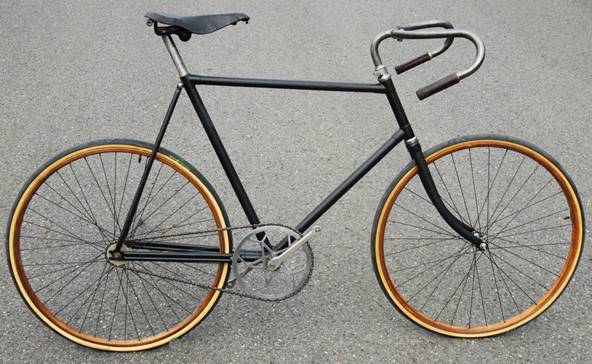
Don't let the familiar appearance mislead you. These racers did not have "freewheeling" or "coaster" hubs; the pedals moved whenever the bicycle did - even in a 150 mile race.
In 1912, derailleurs had not yet been perfected, and they were not used in racing. Before a race began, a rider either chose a gear for the rear axle, or simply used the same gear he always used. Whether racing on level ground, up and down hills, on a wooden track or on a dirt road, mile after mile he used the same gear.
The safety type would never completely go away; year by year, it gradually evolved. Steinert doubtlessly pedaled a safety in his youth, and he certainly raced one. They were much less risky than ordinaries - for one thing, you didn't have as far to fall, and a rider might be able to land on his feet. There still were no brakes, for in that era, bicycle brakes quickly wore down tires, and sometimes caused punctures, but at least the strong legs of the rider were better positioned to use the pedals for slowing his machine.
Of course, having safer machines only encouraged cyclists to take more chances. Wheelmen were still dashing and daring.
The next Hicksville Athletic Club games, in which the A.C. (Steinert was a founding member when the organization began in 1905) competed against representatives of other athletic associations, occurred only eight weeks after Steinert's injury. With barely time to recover, Pete chose to race. Although the level of competition probably did not match what he had faced at Vailsburg, he must have been pleased to win both the one-half mile and five mile races.
|
|
|
A drawback of relying on old newspapers for research is that not all of them have survived, and there are gaps. The extant newspapers show almost no evidence of Steinert's racing in 1910. Perhaps he had little time for the sport due to his job (he was an underwriter for an electric utility). It seems more likely, however, that he needed a prolonged period to heal completely, and then to get his body back into racing condition - which he eventually did. Reports in two 1911 newspapers indicate that he must have done some racing in the prior year, for they refer to Pete's having been the 1910 U.S. National Champion in the quarter-mile. Continued respect for his cycling was further reinforced in 1911, by his winning a half-mile race at the 12,500 seat Newark Velodrome, after which a newspaper reported that Pete Steinert had "regained his form."

https://thecabe.com/forum/threads/toc-tracks-and-velodromes.125781/
That September, Hicksville A.C. held a Cycling Carnival competition, and Steinert had a remarkable day. He had the fastest absolute time in the five mile handicap; he took five seconds off the national record for the one-quarter mile, and he also set a new two mile record, eleven seconds better than the old. He definitely was back.
Making the Team
The modern Olympics had been instituted in 1896, and as late as 1909, a number of nations still were uncertain about continuing with them. The most recent Olympiads had experienced problems: spotty participation in St. Louis in 1904, hasty relocation of the 1908 games (from Rome to London, thanks to the financial impact of the 1906 eruption of Vesuvius), and an overall tendency toward un-Olympic commercialism.
For the 1912 Olympics, a consensus was reached that Stockholm would be the only bidder for the Vth Olympiad, based on its commitment to the perceived principles of the ancient games. In keeping with that commitment, Swedish authorities revisited the list of sports which would be contested, and they decided to exclude cycling. In fact, to make room for other sports venues, they demolished Stockholm's only velodrome. Their decision was met with international opposition in favor of cycling (including one proposal for bicycle polo).
A compromise was reached: there would be one cycling event at Stockholm - a road race, for which individual and national team medals would be awarded. An existing cycling route near Stockholm would be used; local races had been held on it for several years. It was daunting, wrapping around Lake Mälaren on dirt roads, some of them likely to have ruts from automobile traffic. There were hills, some described in the press as "mountainous." Moreover the course was long, measuring not quite 199 miles. It remains the longest course ever used for any type of race in the modern Olympics.
|
|
In the spring of 1912, newspapers around the country carried notices similar to this one. Clearly, endurance was in order. Cyclists who only sprinted, or those who depended on their quick lane changes on velodrome tracks, need not have bothered to attempt the long road races.
|
And so, on the 5th of May, Pete Steinert and 21 other cyclists (some news reports miscounted them) assembled at Floral Park to pedal for 150 miles. There would be three laps. Maps of the precise route do not seem to have survived, but this much is known: from Floral Park, riders raced to Amityville, then went north, passing through Hicksville to Jericho, and then they returned through the same towns to Floral Park to conclude a lap of 50 miles. I do not know if the return trip followed precisely the same roads as the outbound. I also do not know what accommodation was made for the railroad crossings along the way - it is doubtful that the Long Island Railroad would have stopped its trains so that cyclists could cross the tracks ahead of them.
Only ten of the starters finished the race, and the top competitors among them were excellent:

Within a week, seven comparable races had been completed across the country. A news report stated that the top finishers from all eight races would compete against each other on May 24th in a final qualification race, in order to determine the members of the Olympic cycling team. That report was not exactly correct, however....
Well before the final qualifying race, newspapers announced that Pete Steinert had been named to the Olympic cycling team. Apparently, similar news reports appeared around the country for other competitors. For the final qualification race, only twelve competitors assembled at Newark; Steinert was not among them. They raced one mile (six laps) around the track, then continued into Newark and raced 98 miles through New Jersey, returning to the velodrome for the 100th mile. Based on the results of this race, and performances in earlier races, the final roster of the team was named, including alternates to replace any riders who for some reason could not compete in Stockholm.
With their departure for Europe a few weeks away, the athletes had to stay in shape, and the team needed to raise money. Hence, early in June, some of the U.S. Olympians participated in a fund-raising day at Celtic Park(a sports complex in Queens, built by the Greater New York Irish Athletic Association; it was adjacent to Calvary Cemetery). There were track and field events, and also an East-West bicycle race, with Steinert (who, thanks to his mother Agnes, was half Irish) competing for the East.

wingedfist.org/Celtic_Park_History.html
Two days before the athletes departed for the Olympics, the Hicksville A.C. honored Steinert, at a dinner at Hicksville's Wolgast Hotel. Among the several speakers was his father, the venerable Judge. Pete was presented with an inscribed silver cup, in honor of both the work he had done for the club, and his representing his country in the upcoming games. Some of those present posed for a group photo, which later was published in the Long Islander newspaper (shown below, with annotations added). Steinert, his bicycle, his father, and three of his six brothers appear in the image.

Note that the Long Islander labels the man seated to the left of the bicycle as "James Jr." He is either James Steinert, or he is Joseph Steinert Jr.
The opening ceremonies for the 1912 Olympics began late on the morning of July 6th, each nation's athletes following their country's flag as they marched into the stadium. With the entrance of the Japanese team, the games became the first Olympics to include competitors from five continents. King Gustav V spoke; he would continue to participate in ceremonies during the games, personally awarding medals to athletes.

Athletes Entering (the U.S. Team is wearing dark blazers) / olympic.org/stockholm-1912
The cycling race was to be contested the next day. The determination of the team medals would be straightforward: the times of each nation's top four finishers would determine the rankings. With regard to the official log of the participants, any rider who crossed the finish line with a time more than 25% above that of the winner would be deemed to have not finished the race. The cyclists had been assigned to groups for the staggered start, with each group departing at a fixed time. As the first group was to start at 2:00 AM, it is doubtful that many cyclists lingered at the conclusion of the opening ceremonies.
Some motion picture footage of the race survives. The screen shot below was taken from https://www.youtube.com/watch?v=f7c7Nka_LHE It includes about a minute of film clips.
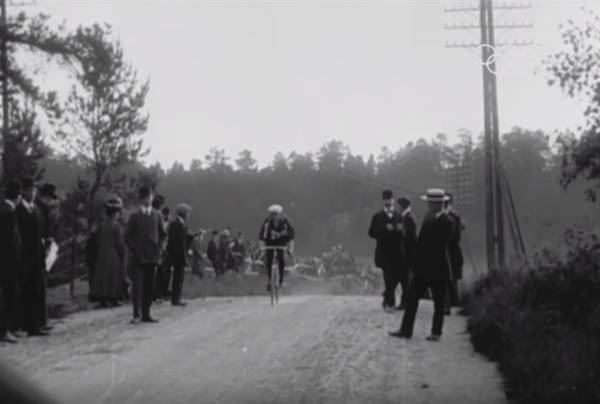
olympic.org
120 cyclists started the race. Rudolph Lewis, a South African, was the individual winner, having completed the course in 10:42:39, with an average speed over 199 miles of more than 18.5 mph. American Carl Otto Schutte of Kansas City was third at 10:52:87. Pete Steinert finished at 12:08:13, well behind, but still among the top half of the starters. The team winner was Sweden, with a four-man total time of 44:35:34 (the top four Swedish riders, very familiar with the course, consecutively finished seventh through tenth). As in the individual rankings, Great Britain was second in the team rankings, and the U.S. was third, with its top four riders totaling 44:47:55, exactly 42 minutes ahead of the next team's total.
From an American perspective, Schutte was the cycling story of the games. In the 150 mile qualifier in the heat of St. Louis, his winning time against a handful of opponents had been an unspectacular 10:42:05, nearly the same time it took him to ride 49 miles further in Stockholm. In the final qualifying race in Newark, his pace had been much more impressive, but doubts had lingered about his endurance beyond 100 miles.
|
Pete Steinert, and the other American cyclists who finished below the top four, must have felt some disappointment. Nonetheless, their hours spent pedaling over 199 miles of unfamiliar terrain had demonstrated that they ranked in the upper echelon of the world's best. Indeed, even using the average speed of the top eight Americans instead of only the fastest four, the U.S. still would have won the team bronze, and by good margin. Like all the participants in the games, they each received a pewter medal, as illustrated here. Afterwards, the cyclists would have explored Stockholm, and watched the other events. Pete did not remain in Sweden until the end; with other Americans whose events had completed, he traveled to Dover, and on July 21st he sailed for the U.S. aboard the S.S. Vaderland. |
olympicartifacts.com |
When the ship arrived in New York on July 31st, the Olympians were greeted by exultant reporters, family members, colleagues, and friends. One newspaper article took some liberties, referring to the group of returnees as "America's victorious Olympic athletes."
Life After Cycling
Soon to turn 29, Pete seemed to leave cycling competitions behind (at least, his name no longer appeared in newspapers in that context). Late in 1913, he married a young Brooklyn woman; they honeymooned in Bermuda, and settled down in Mineola. Later, he and his wife moved their family to Jamaica, next door to that of Pete's brother William. He frequently returned to Hicksville, either for family visits, or to remain active in the Athletic Club, supporting its activities and coaching athletes in a number of sports. He also advised cyclists, both professional and amateur, on their training.
During World War I, he worked in Washington, D.C. for the War Industries Board, as Assistant Chief of its Fire Prevention Section. Later, he managed the New York office of the Automobile Underwriters Detective Agency.
Pete passed away in 1966, a month before his 83rd birthday. He was buried in Hicksville's Plainlawn Cemetery. Among the others buried in the plot is his brother William.

BillionGraves.com
Researching Jerome Steinert from old news reports has been an interesting exercise. Like today's sports reporters, the newshounds of a century ago were prone to be overly optimistic or pessimistic. As noted earlier, facts sometimes gave way to reporters' gut feelings.
All memories can fade, but some grow with the passage of time. For example, years after one of Hicksville's own went off to the 1912 games, a reporter wrote a retrospective article about local athletes. It mentioned another cyclist, saying he also had been named to the Olympic cycling team, but "as a sub," and had been unable to attend the games for financial reasons. Well... a review of newspapers of the day turns up no reference to the fellow with respect to the Olympic qualifying races. Nor does the official list of the men selected for the team - pending their ability to raise the necessary funds to go to Stockholm - include him. The cyclist may or may not have been good enough to compete at the games, but apparently he did not try to qualify, and he clearly was not named to the team in any way. Such reporting, although perhaps well-intentioned, is mere hype.
Long after his foray to Stockholm, Pete Steinert was a spectator at a professional cycling race in Manhattan. The next day, a newspaper article about the event mentioned him, and it remarked in passing that he was the "greatest American road rider" the U.S. had seen. At first glance, one might be tempted to also dismiss this as sports hype, but I think that the reporter meant what he said.
It is easy to call a perennial champion great, but Steinert was not a perennial champ. Calling him great, and in fact the greatest of all, while knowing that he competed in an Olympics without medalling, is not something that one would do frivolously. It suggests that although Pete Steinert did not win an overwhelming collection of medals, championships, and glory, the reporter saw in him an abundance of character, and the essence of greatness.
One suspects that Steinert soon rebounded from any disappointment which he felt after Stockholm. The Olympics had magnified everything, especially in the eyes of the public, but they were not the proper standard by which to measure his career. The race in Stockholm was a one-off, atypical of the events in which Pete and his peers competed - even the qualifying races were longer than any other American cycling event had ever been. And yet, on July 7th 1912, pedaling non-stop for nearly 200 miles, Pete was able to finish amongst many of the world's best. In American cycling, on tracks and over roads, he had proved himself a fine cyclist, a solid performer, one who did not shy away from tough competition, and one who set records along the way. Pete Steinert was entitled to hold his head high.
***
And to close...
A different take on the "Winged Victory" theme: a c.1912 bicycle advertisement, designed to appeal to the dashing wheelman
https://www.OldBike.eu/museum
/